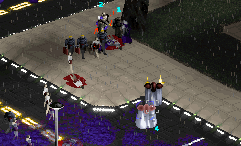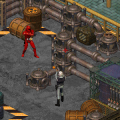Syndicate Wars follows the basic plotline established in American Revolt – Eurocorp has taken over the globe and installed each of its citizens with a chip that makes them believe they’re living in a bright and smiley world of happiness instead of the bleak and crappy reality. An opposing force, who call themselves The Church of the New Epoch, begins sending out waves to deactivate the chip, and thus hoping to incite a revolt. The full motion video intro shows this whole process from the point of view of a regular person, whose notion of reality slowly crumbles, before he’s ruthlessly terminated by some Eurocorp agents.
Syndicate Wars offers two factions, where you either play as Eurocorp, quelling various uprisings, or as the Church, sparking rebellion. In practice, the difference is largely cosmetic, because both play more or less the same. The basic controls haven’t changed much, although the pacing is much faster, which promotes more action-packed gameplay. No longer will your agents saunter across the map, as they’ll run whenever you double click. The pathfinding is much better, and it’s far easier to read the radar. Guiding vehicles is also much improved, considering they’ll pull off to the side of the ride to await orders instead of cruising along mindlessly. Selecting and deselecting groups of agents is still more of a pain than it should be, but as a whole the interface is much more solid.
For those types of gamers who would just fire up Syndicate to see what kind of destruction they could cause, Syndicate Wars increases the havoc by several orders of magnitude. In keeping with the faster tempo, the pistols and shotguns are gone, with the Uzi now being the default weapon. Old favorites like the Flamer, Minigun and Gauss Gun (here termed the Launcher) return, but new weapons include the Pulse Laser, Electron Mace, Plasma Lance, two types of gas, and two kinds of high explosives, not to mention the Satellite Rain, which bombards an area with a series of devastating attacks. Furthermore, practically all of the buildings are destructible, allowing you to demolish entire city blocks with the right equipment. (In keeping with the parallels to the later sandbox games, this feature wasn’t introduced until Pandemic’s Mercenaries in 2005.) New items allow for even more tactical advantages – trip wires can be set up to trap enemies, the Statis Field to slow down surrounding characters, the Chromotap to steal health from anyone around you, Medikits to regain health, and a Cerberus IFF robotic guardian, which can be deployed to guard certain areas.
The game world is now fully 3D, and the camera can be rotated with the keyboard. This might seem like a huge step over the 2D visuals of its predecessor, and at first glance, it is. It’s much darker, more closely emulating the look of Blade Runner, and even has occasional weather effects like pouring rain. The video screens are even more fully animated, and shows clips from the anime Ghost in the Shell, which was released around the same time. (Certain trucks also bear the logo of Manga Entertainment, its North American publisher.) The music is restricted to a small handful of looping CD audio tracks, which, predictably, take a bit after Vangelis’ score in Blade Runner. It’s mostly atmospheric electronica with some Asian instrumentation occasionally tossed in, which has a tendency to get repetitive, but it’s still quite cool. The weird gibberish acknowledgment when picking agents has also been replaced with an more understandable “SELECTED”. Maybe that’s what they were supposed to have been saying the whole time?
There are also numerous basic design changes, some for the better, some not so much. Instead of ammunition, all weapons are powered by the same energy pool, which is shared amongst all four agents. Since it recharges after time, this means you never need to carry more than one weapon type, and eliminates all of that annoying arsenal juggling. On the same note, your agents now have shields, which will absorb quite a bit of damage before directly harming your agents. The shields regenerate slowly, and it feels like an early implementation of this kind of life meter that was popularized in Bungie’s Halo in 2001. The drugs have changed, and instead just send your agents into varying states of panic. Like American Revolt, there is a multiplayer option, but it is only available over Local Area Networks.
Most annoyingly, money is no longer obtained via taxation, but is instead acquired via selling weapons you’ve picked up, and by robbing banks. Although they’re tough to make out amongst the dense urban jungles, banks are valuable secondary targets, and wringing them dry is pretty much the only way you can properly research and equip your characters. Because of this, you can no longer cheat by sitting on the status screen, but at the same time feels like an ill fitting solution to the problem. The banks aren’t nearly prolific enough, and it’s extremely restrictive in the early parts of the game. Killing civilians also bears a monetary penalty, perhaps so all of the violence against innocents bears some kind of punishment, but it really is quite annoying. Policeman will also fire upon if you’re wielding a Persuadertron, whereas in the first game they looked right past it, so gathering up hordes of minions is more difficult.
Despite all of the enhancements, Syndicate Wars ultimately falls prey to the same problems as the original, plus new ones. Despite the ability to rotate the camera, there are still just way too many instances where the numerous skyscrapers get in way of the action. The scrolling is so sluggish and the visuals so dark that your agents are usually riddled with bullets by the time you get a grasp on the situation. It doesn’t help that the camera is zoomed in way too close. You can slightly change the zoom level, but even that’s restrained by your currently equipped weapon. While the environments look fantastic, all of the sprites are extremely low resolution and very pixellated. This effect further exacerbated when you run in SVGA, which smoothens the terrain but uses the exact same sprites. And, much like the first game, there’s really no variation in the environments at all.
Syndicate Wars might seem like a huge improvement on paper, but overwhelmingly chaotic nature of the action and some questionable design decisions just makes everything far too confusing. Sitting down and legitimately trying to play through the campaigns will probably only result in annoyance. It’s much better to just turn on some cheats just to muck around with the weapons and demolish everything in sight.
Ports were planned for both the PlayStation and Saturn, but only the PlayStation version was ever released. While it’s restricted to low resolution mode, it actually looks a bit better than the PC version (running in VGA, anyway), with better, colored lightning and transparent explosions. Certain larger structures are also transparent, and in general there’s less obstructing your view. Naturally, though, controlling your agents is still cumbersome. Most of them time, you control them directly via the control pad, although you can scroll around the map and point to their destinations, if you choose. But, like the console ports of the original Syndicate, memorizing all of the different button combinations is a huge pain. At least it supports the PlayStation Mouse, which eliminates most of the problems, although good luck finding one of those.
Many of the maps have changed, and some missions are completely different. All of the research aspects are removed, and instead you’re given access to new weapons and upgrades at set intervals. Each agent also has their own ammo energy pool, instead of having it shared amongst all members. The intro is completely different too, as it focuses on an airborne car chase throughout the city – perhaps the PC version was a bit too bleak? It’s actually a bit amazing that this got a Teen ESRB rating.


